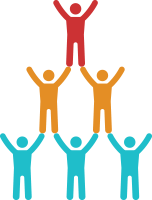Everyone has a role to play in sport to be part of the solution in ending sexual and domestic violence (SV/DV). Click on each role to find out how these individuals are being engaged to end SV/DV in and through sport!
SPORT is part of the solution to ending SV/DV
Values, norms, and behaviors can be taught and reinforced throughout the sport pipeline to cultivate and support healthy individuals, teams, and communities – and thus, contributing to ending sexual and domestic violence (SV/DV) in one generation.

Explore SV/DV Prevention Strategies in Sport by:
Sports teaches accountability, social cohesion, and self-control, all of which are SV prevention factors. 1Holt NL. Positive youth development through sport, 2nd ed. NY, NY: Routledge; 2016.


Where are the solutions
Sport is a powerful partner in ending sexual and domestic violence (SV/DV) when each part of the sport pipeline – from youth to high school to college to pro sport individuals and organizations - is engaged and building on SV/DV prevention efforts.
Athletes and coaches are community leaders and can have enormous influence on changing the paradigms related to masculinity, aggression, and acceptability of SV. 1Beaty RP, Dobosz LA. The relationship between athletic participation and high school students’ leadership ability. Adolescence. 1999;34(133):215.2Jaime MCD, McCauley HL, Tancredi DJ, et al. Athletic coaches as violence prevention advocates. Journal of interpersonal violence. 2015;30(7):1090-1111.

How to be part of the solution
There are many strategies already being used in sport to prevent sexual and domestic violence (SV/DV). Sport individuals and organizations will have the greatest impact in preventing SV/DV in and through sport by using multiple strategies simultaneously.






















